Inconscious, efficient, comfortable heating. Very attractive combination of characteristics. Many on the mind immediately comes a warm floor. And right. But this is not the only way of heating, which corresponds to these characteristics. There is still warm plinth. The system is mounted easier, most of it is available for maintenance at any time. So hearing plinth is also worth considering as an option of invisible heating.
Warm plinth system: what it is
Heating plinth or plinth heating is not a novelty in the heating area. The idea was offered at the beginning of the last century, but due to the complexity of sales and high prices, was almost forgotten. With the development of technologies, the complexity has become lower, but the price is still high. This is, basically, and holds back potential users.
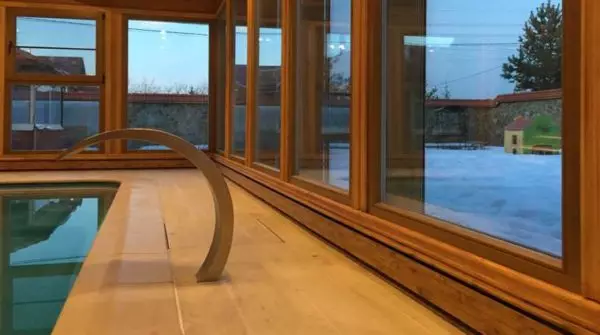
This may look like heating with warm plinth
The main difference between this system is a non-standard form of heating devices and an unusual location. Heaters - long and low, are located around the perimeter of the floor at the floor level. Heating devices are closed with a long decorative plank in appearance very similar to the plinth. When installing, replace the usual plinth. Therefore, such a system is very often called "warm plinth". This system is very good with panoramic glazing - it may not be higher than the frames, so it is completely invisible. She is not worse and in ordinary rooms - it is not visible at all.
Types of warm plinth
Warm plinth is two types: electric and water. Electric warm plinth is characterized by the fact that each heating device is independent and can work separately. They can be installed in the event of a lack of capacity of the main heating - as an additional, in case of cold weather. Installation is simple, and it works efficiently, it is impaired, it does not dry too much.

Warm plinth without decorative panel
There is a water warm plinth. This is one of the subspecies of water heating, that is, all heating devices are connected to one system. It can be both the main (only plinth heaters) and an additional type of heating (along with a water warm floor or radiators).
Device of heating plinth
In any case, the warm plinth looks like this: these are two copper tubes that are one from the other are at a distance of 7-15 cm. To increase the heat transfer on the tubes, vertical plates made of aluminum, brass (cost a little less, but also the heat transfer is slightly lower) or copper (more expensive and more "warm" option). On top of the pipe with fins, closed with decorative lids from extruded aluminum. Aluminum is not chosen by chance - it is well transmitted warm. So the heated cover itself radiates heat.
At the top and bottom of the lid there are holes for air movement. Through the bottom is suused cold, through the top is heated. So it turns out heating comes from three sources:
- Air heats up, which passes along the pipes and fins.
- From heated walls.
- From the housing of the warm metal plinth.
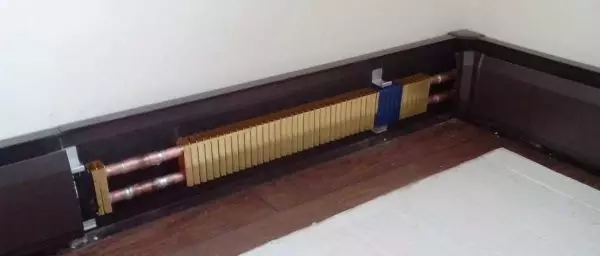
So the system looks like before installing a protective and decorative plank
Such a triple heat source contributes to the fact that the room heats up quickly, and the location of the heating elements around the perimeter contributes to uniform heating of air throughout the volume.
Advantages and disadvantages of plinth heating
What is the difference between heating using warm plinth? Warm air is understood from the heating element up, along the wall, warming up the wall. As you move up, the air is minimally cooled, then lowered down, but not along the wall, but in the center of the room.
As a result, it turns out that the warmest air is located downstairs around the perimeter of the room. The warmest object - except heaters are walls. Also, warmer air is located at the floor. Lifting up, it cools and at the head level it is a little colder. The difference is small 1-2 degrees, but it is such a temperature distribution is better for human well-being.
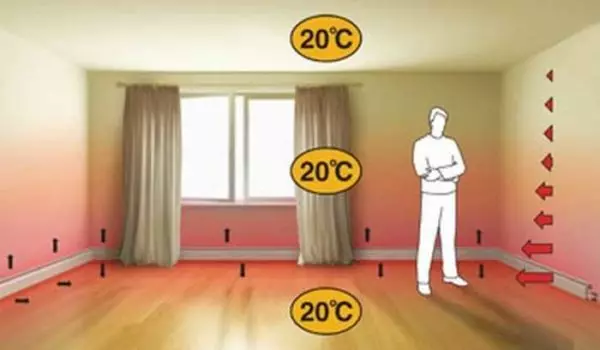
Uniform distribution of heat over the entire area and volume is one of the most important advantages.
Heating with a warm plinth is inertial. Unambiguously attribute this property to advantages or disadvantages will not work. There are positive, and negative moments. Minus: while the walls do not warm up, the room is cool. Therefore, such a system is good only for permanent residence homes and is completely not suitable for giving. The positive moment is that heating, the walls work as a large stabilizer - maintain the temperature at one level, giving the accumulated heat if necessary. Such a large heat accumulator will help hold out for some time even in case of disconnection of heating.
The pros of the heating system with heating plinths belongs to their economy. After the walls are warm, the boiler consumes the minimum of fuel - only to maintain temperature. And such modes are usually more economical. But this applies to any inertial heating system, so it is impossible to consider the special advantage of a warm plinth.

Warm plinth assembly is a bit closer
Plinthic heating and undeniable advantages. The first is one of the few systems that ensures uniform heating. Even the angles are always warm. The second is the most inconspicuous system that is easily fits into any interior. With all at the same time, heating devices are easily accessible, the system can be repaired at any time.
It has a warm plinth and explicit drawback - a high price. This is due to the fact that it uses copper and aluminum to increase heat transfer, and they are worth a lot.
Types of heating plinths
The plinning heating system can be of two types: with electrical and water heaters. At the installation stage, a system with water warm plinths is more complicated (a collector or radial connection is required), but it is more economical during operation. Electric warm plinth is mounted quickly - it is only necessary to fix heaters to the wall, immediately the installation field it is ready for operation. But the cost of heating, as well as in any electrical installation, high.
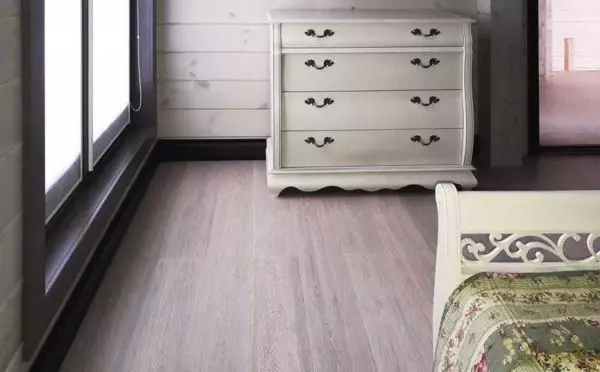
One of the most invisible heating systems - warm (heating) plinth
Heating device with water warm plinth
The water plinning heating system differs only by non-standard formation of heating devices. The key components do not differ from the standard: you need a water boiler, a collector node and a pipe system, with which the warm plinth is connected.
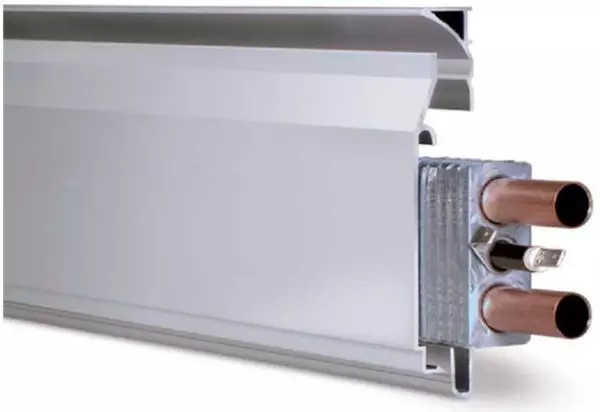
There is still a combined warm plinth - with electric tan and pipes for the coolant
Please note: the optimal mode of operation of the system is low-temperature. At the supply of 40-50 ° C, the return on about 5 ° C is below. Therefore, pick the boiler or build the system must be based on this. If the boiler is a gas, the optimal choice is condensing. When installing any other, a heat battery and / or a mixing unit is needed in the system - to reduce and stabilize the temperature.
Connection method
There are features and in choosing a way to connect. The sequential connection of all plinning heaters in the room is inefficient: so far the heat carrier will reach the latter in the heater in the branch, it will greatly cool and they will stay cold almost all the time.
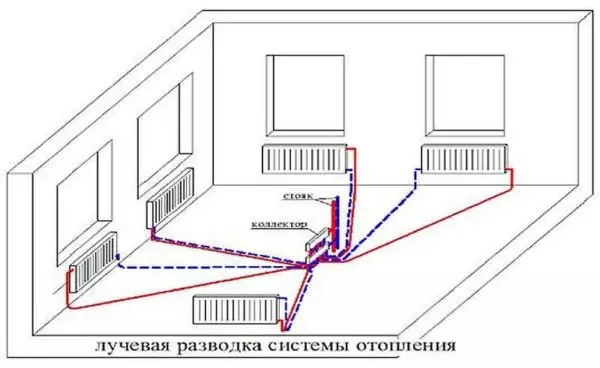
The radiation connection scheme looks like this.
For water heating plinth, the radial system is used: the devices are connected one or pairwise. To do this, the collector node is embedded in the system, to which the pipes are connected, which go to the heating devices. The lack of such a system is a big flow consumption. After all, there are two pipes for each instrument (or a small group) - for feeding and reverse. Pipe consumption is much larger, but heat distribution is more uniformly and the system itself is more reliable. Why is more reliable? In case of damage to pipes or radiators in the same group, all other work normally.
FEATURES OF MONTAGE
When the water plinning heating is used, the pipes usually hide in the floor. It will not work along the walls along the walls, since the place is occupied by heating devices. That is, the installation of water warm plinths is possible only at the stage of repair - you have to raise the floors.
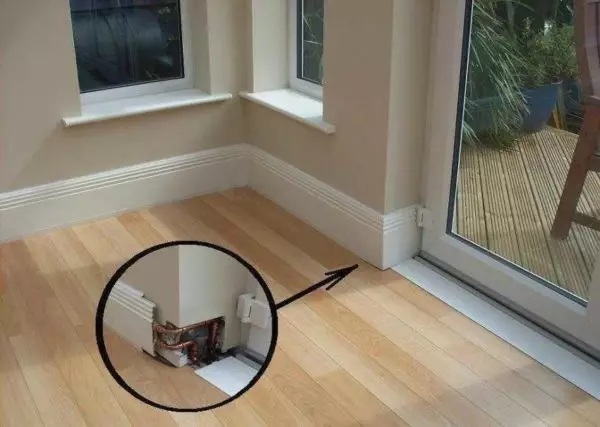
In the mounted state very attractive
Special polymer pipes are recommended in the screed - they are not subject to corrosion and have low heat transfer, that is, heat losses during the transportation of the coolant will be small. But since the accessibility for repairing these systems is small, we need to take a quality product of well-known manufacturers, and this is not suiced.
Electric warm plinth
Electric warm plinth externally from water differs only by the presence of terminals for power supply. The rest is the same. These are two tubes with perpendicularly attached aluminum / brass / copper plates. In the lower tube there is a heating element - TEN, in the top lay the wires to connect.
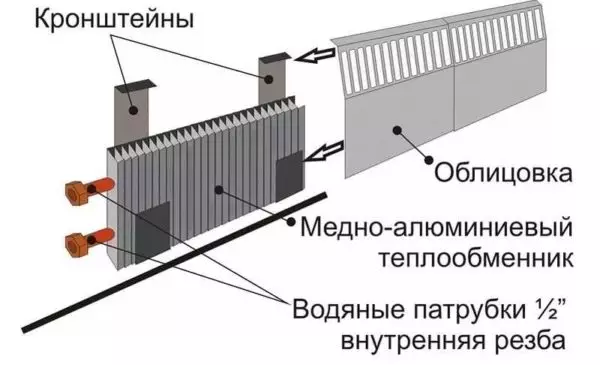
Total Device of Heating Plinth
Mount and connect electric warm plinth is much easier. It should only be consolidated, stretch the wires and connect them to the terminals. To maintain a given temperature, the thermostat is embedded in the system, which includes and turns off the heaters. The use of thermostats is desirable, as it optimizes the work - saves electricity.
Installation is really simple, but it is necessary to connect the electric warm plinth to a dedicated line with a properly selected value of the protection automaton and copper single-liner wires of the corresponding cross section. So in this case, the repair is required - the wiring is taken to lay in the wall, and for this you need to make a shit, that is, break the walls.
Installation of a water warm plinth system
Installation of electric warm plinth is very simple: fasten on the wall. All, the system is ready to operate. It remains to be included in the outlet. The main thing is to be correctly calculated by the cross section of the wire, there were protective machines of the correct nominal. This is the main problem in the case of the use of electric warm plinth. Water mounted much more difficult. Everything should be collected in a single system, and this is not easy.
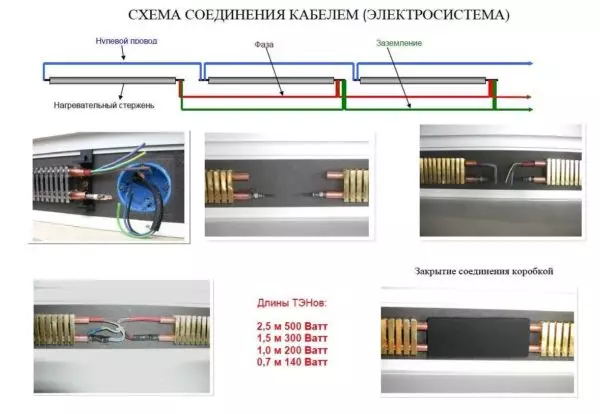
Installation of heating plinth: you need to know the nuances
Calculation of plinth heating
The complete heat engineering calculation of heating is a long and complex matter. The size and geometry of the room, the material of the walls, gender, the ceiling is taken into account, the degree of insulation of all structural elements is taken into account, including windows, doors. In general, the calculation is quite difficult. Therefore, most often take the average figure, which is derived as a result of the analysis of many calculations.
It is believed that for heating one square meter of the area of the room with an average insulation, 100 W thermal energy is necessary. That is, to calculate the power of a warm plinth, you must multiply the room at 100. Get the desired figure. It is so much (and it is better about 20-25% more than 20-25%) should give in the amount of all elements of a warm plinth.
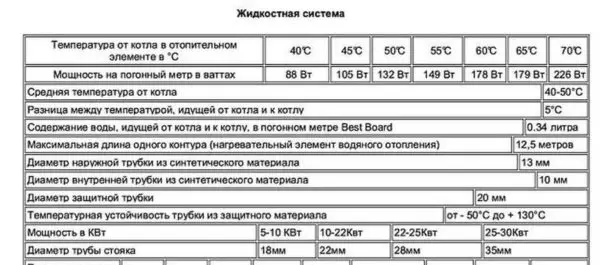
Example of the technical characteristics of the Best Board warm plinth for different system operation modes
For example, the room is 18 square meters. It will take 1800 watts for her heating. Further, we look at how much heat allocates one meter of heating. Water heating plinth can be operated in different modes, depending on the mode allocates different amounts of heat. The table above shows the data for one of the systems. For example, we take the heat transfer of one meter of warm plinth from this table (other manufacturers may have significant differences).
For example, the system will operate with a flow temperature of 50 ° C. Then one mongrel meter issues 132 W heat. To heat this room, it will be necessary to 1800/132 = 13.6 m of warm plinth. When ordering, it is better to add a stock at 20-25%. This stock is necessary to ensure that the system does not work all the time at the limit. This time. And also in case of abnormal cold weather. These are two. So, with a reserve we take 17 meters.
We will pay your attention again: this is the average data for a certain average house. Moreover, even the height of the ceilings is not taken into account. It takes the average again - 2.5 meters. If you have better insulation, you will need less heat if worse than "medium" is more. In general, this method only gives approximate calculations.
How to act
The first thing to be done is to draw a plan on which to designate the length of each heating device, the length of the connecting tubes. After all, the length of the warm plinth is not always equal to the perimeter of the room. In this case, segments of heating devices are combined with copper or polymer pipes. Use steel undesirable, as they chemically interact with copper (it gradually collapses).
Preparation for installation occurs long before its actual start. At the very beginning of the repair, even before the start of alignment of the floor, the pipes from the boiler or the collector node are stretching to the place of connecting the warm plinth. Pipes are stacked, tested for integrity, poured with a screed in the filled state under pressure (working pressure in a private house 2-3 atm, in a multi-storey need to be recognized in the HSE). Then all repairs are carried out and only after the finish finish of the walls and the floor begins the installation of warm plinth. Here is its order:
- The heat transmission tape is mounted on the perimeter of the walls. It prevents heat consumption for wall heating.
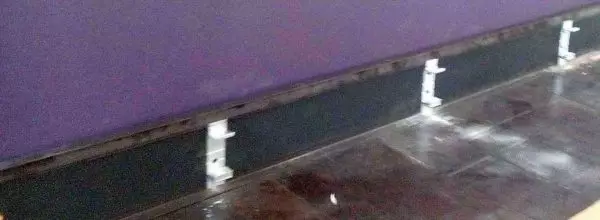
The heat-insulating tape is attached, and on top of it fastening elements
- On top of the tape in 50-60 cm increments are installed fasteners. They are fixed to the wall with a dowel or self-tapping screws (depending on the material of the walls).
- In the fasteners, the segments of the heating plinth are fixed according to the plan, interconnected with copper or polymer trumpets.
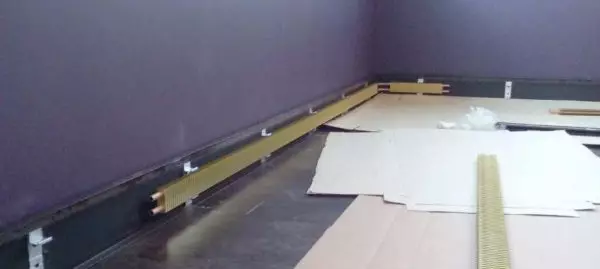
Install pieces and connect them into a single whole
- The tightness of the system is checked with crimping.
- If everything is fine, pipes from the collector node or from the boiler are connected, the system is filled with the coolant and is tested.
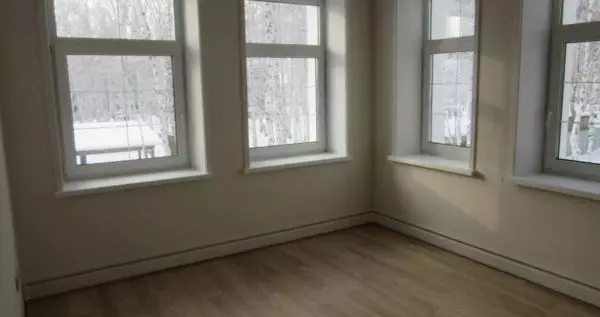
So everything looks when everything is done
- After successful tests, decorative lids are installed, the plinning heating system is ready for operation.
Actually, the installation of warm plinths is not too complicated. But the tightness of the connections is important and this is necessary to pay special attention.
Article on the topic: How to make a dryer for linen on a balcony with your own hands
